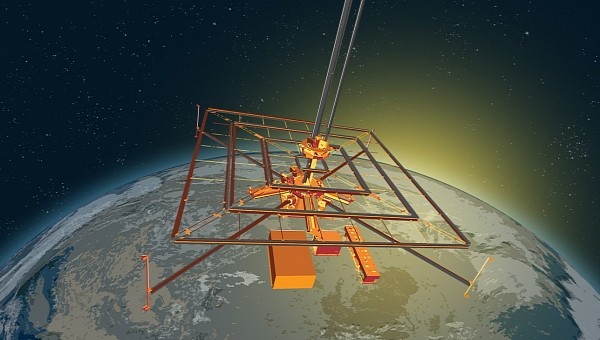Decades ago, space was only a mystery that needed to be explored in order to be understood. The puzzle is still far from being “solved” (if it ever will be) but a whole new dimension was added within the past years, and continues to grow – space’s potential to make life on Earth better. One of the most remarkable projects following this trend aims to provide clean energy to areas on the globe where it’s mostly needed, straight from space.
On January 3, the Transporter-6 mission was launched, and the Momentus Vigoride spacecraft aboard the SpaceX rocket carried a very special payload. It’s the SSPD (Space Solar Power Demonstrator) developed by a team of scientists at Caltech (California Institute of Technology).
It’s a huge milestone within the ambitious plan of harvesting solar power in space and then sending it back to Earth, as electricity. As its name shows, this is only a prototype that will be used to test and validate the project’s key technology.
But even if the feedback doesn’t turn out as great as expected, this will still be a huge step in advancing space solar technology.
It all started with a Popular Science article, but it took more than $100 million, and over a decade, to get to where it is today. Philanthropist Donald Brent, also a lifetime member of the Caltech Board of Trustees, became fascinated with the idea of space solar power after reading about it in Popular Science. He proposed this research project to Caltech’s then-president Jean Lou Chameau, and also funded it.
Exactly a decade after Brent and his wife donated for the project, the SSPD is being launched into space. What makes this satellite prototype incredible is that everything about it had to be designed and built from scratch, simply because there had been nothing like it before.
This includes things like innovative composite materials that are ultra-thin, a brand-new architecture for solar-powered spacecraft, and new electronic chips for wireless power transfer.
The potential benefit of harvesting solar power from space is easy to see – without all the negative factors that come with the Earth's atmosphere, outer space can basically provide unlimited solar energy.
However, the challenges are also greater. Things like bulky solar panels and conventional wiring had to be replaced with alternatives that were created from scratch. And it was all done by a team of just 35 graduate students and researchers at Caltech – a surprisingly small number, considering the magnitude of this trailblazing project.
The SSPD weighs around 50 kg (110 lbs) and will be testing three main components: DOLCE (a structure that demonstrated the architecture of the future modular spacecraft), ALBA (22 different types of photovoltaic cells) and MAPLE (an array of power transmitters). An additional system of electronics is used to control the three experiments.
Over the next months, all of these components will be thoroughly tested, and the feedback will be used to take the space solar project even further.
It’s a huge milestone within the ambitious plan of harvesting solar power in space and then sending it back to Earth, as electricity. As its name shows, this is only a prototype that will be used to test and validate the project’s key technology.
But even if the feedback doesn’t turn out as great as expected, this will still be a huge step in advancing space solar technology.
It all started with a Popular Science article, but it took more than $100 million, and over a decade, to get to where it is today. Philanthropist Donald Brent, also a lifetime member of the Caltech Board of Trustees, became fascinated with the idea of space solar power after reading about it in Popular Science. He proposed this research project to Caltech’s then-president Jean Lou Chameau, and also funded it.
Exactly a decade after Brent and his wife donated for the project, the SSPD is being launched into space. What makes this satellite prototype incredible is that everything about it had to be designed and built from scratch, simply because there had been nothing like it before.
This includes things like innovative composite materials that are ultra-thin, a brand-new architecture for solar-powered spacecraft, and new electronic chips for wireless power transfer.
The potential benefit of harvesting solar power from space is easy to see – without all the negative factors that come with the Earth's atmosphere, outer space can basically provide unlimited solar energy.
However, the challenges are also greater. Things like bulky solar panels and conventional wiring had to be replaced with alternatives that were created from scratch. And it was all done by a team of just 35 graduate students and researchers at Caltech – a surprisingly small number, considering the magnitude of this trailblazing project.
The SSPD weighs around 50 kg (110 lbs) and will be testing three main components: DOLCE (a structure that demonstrated the architecture of the future modular spacecraft), ALBA (22 different types of photovoltaic cells) and MAPLE (an array of power transmitters). An additional system of electronics is used to control the three experiments.
Over the next months, all of these components will be thoroughly tested, and the feedback will be used to take the space solar project even further.







